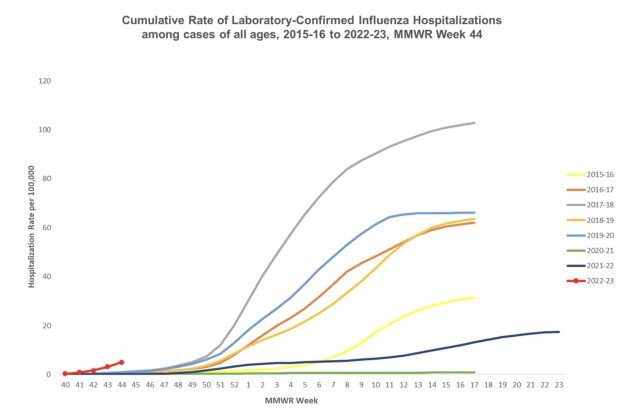The US continues to see a dramatic and early surge in respiratory illnesses, which is hitting young children particularly hard and setting records for the decade.
The Southeast region is the most affected by the surge, which is driven by cases of flu, RSV (respiratory syncytial (sin-SISH-uhl) virus), and other seasonal respiratory viruses. Seven southern states—Alabama, Georgia, North Carolina, South Carolina, Mississippi, Tennessee, and Virginia—have reached the highest level of respiratory-illness activity on the scale from the Centers for Disease Control and Prevention. The states are colored a deep purple on the national map, representing the highest of sub-level of “Very High” activity.
Overall, 25 states are experiencing “High” or “Very High” levels of respiratory illness activity, while six have reached the moderate category.
Outpatient cases and hospitalizations are climbing and have not (yet) surpassed the peaks of all past seasons. However, the levels they’ve reached at this point in the flu season—week 44 of the year—are higher than levels seen at this point in every year since 2010, the CDC notes. The agency estimates that, so far this season, there have been at least 2.8 million illnesses, 23,000 hospitalizations, and 1,300 deaths from flu. This week, the agency tallied three pediatric flu deaths, bringing the season’s total to five.

Influenza-like illnesses (ILI) are driving more children to seek outpatient care, compared with all other age groups—15.4 percent of outpatient visits by children ages 0 to 4 years were for ILI, and 10 percent were for ILI among people aged 5 to 24 years.

The cumulative hospitalization rate per 100,000 people for week 44 is the highest it’s been since 2010, at 5 per 100,000. For reference, all seasons between 2010 and 2021 had hospitalization rates for week 44 ranging from just 0.1 to 0.7. Broken out by age, the highest rates for this year’s week 44 were among adults aged 65 or older (10.7 per 100,000), followed by children aged 0 to 4 years (9.3 per 100,000), then adults aged 50-64 (4.9), children aged 5-17 years (5.0), and adults aged 18-49 years (2.6).

In the CDC’s surveillance of the circulating flu strains, the season seems to be driven by an H3N2 strain of influenza virus, which is well-matched for the season’s flu shot. However, the uptake of flu shots is behind where it normally is for the season, even though circulation is ahead of normal patterns, the CDC noted.
“Flu vaccine uptake has lagged compared to prior seasons,” CDC Director Rochelle Walenksy tweeted from her verified CDC account Friday. “It is time to get your flu vaccine as well as your updated COVID19 vaccine if you have not yet done so.”